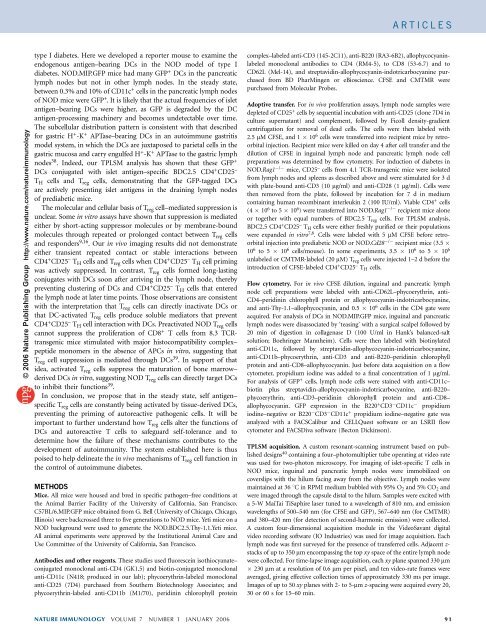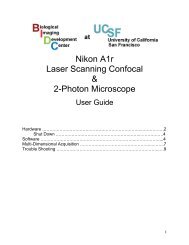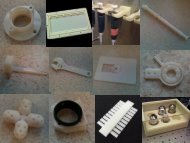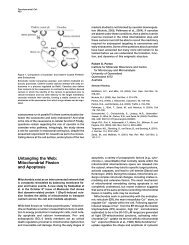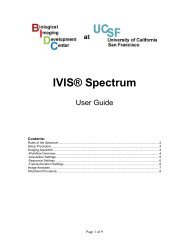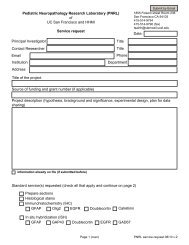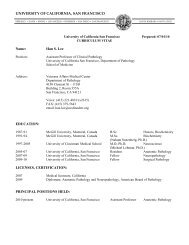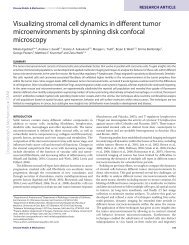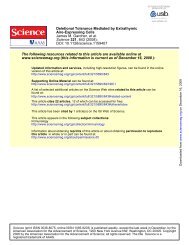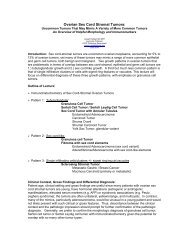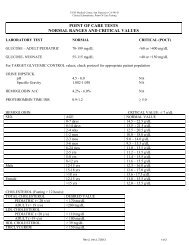Tang et al. Nature Immunology. 2006 - Departments of Pathology ...
Tang et al. Nature Immunology. 2006 - Departments of Pathology ...
Tang et al. Nature Immunology. 2006 - Departments of Pathology ...
You also want an ePaper? Increase the reach of your titles
YUMPU automatically turns print PDFs into web optimized ePapers that Google loves.
ARTICLES<br />
© <strong>2006</strong> <strong>Nature</strong> Publishing Group http://www.nature.com/natureimmunology<br />
type I diab<strong>et</strong>es. Here we developed a reporter mouse to examine the<br />
endogenous antigen–bearing DCs in the NOD model <strong>of</strong> type I<br />
diab<strong>et</strong>es. NOD.MIP.GFP mice had many GFP + DCs in the pancreatic<br />
lymph nodes but not in other lymph nodes. In the steady state,<br />
b<strong>et</strong>ween 0.3% and 10% <strong>of</strong> CD11c + cells in the pancreatic lymph nodes<br />
<strong>of</strong> NOD mice were GFP + . It is likely that the actu<strong>al</strong> frequencies <strong>of</strong> isl<strong>et</strong><br />
antigen–bearing DCs were higher, as GFP is degraded by the DC<br />
antigen-processing machinery and becomes und<strong>et</strong>ectable over time.<br />
The subcellular distribution pattern is consistent with that described<br />
for gastric H + -K + APTase–bearing DCs in an autoimmune gastritis<br />
model system, in which the DCs are juxtaposed to pari<strong>et</strong><strong>al</strong> cells in the<br />
gastric mucosa and carry engulfed H + -K + APTase to the gastric lymph<br />
nodes 38 . Indeed, our TPLSM an<strong>al</strong>ysis has shown that these GFP +<br />
DCs conjugated with isl<strong>et</strong> antigen–specific BDC2.5 CD4 + CD25 –<br />
T H cells and T reg cells, demonstrating that the GFP-tagged DCs<br />
are actively presenting isl<strong>et</strong> antigens in the draining lymph nodes<br />
<strong>of</strong> prediab<strong>et</strong>ic mice.<br />
The molecular and cellular basis <strong>of</strong> T reg cell–mediated suppression is<br />
unclear. Some in vitro assays have shown that suppression is mediated<br />
either by short-acting suppressor molecules or by membrane-bound<br />
molecules through repeated or prolonged contact b<strong>et</strong>ween T reg cells<br />
and responders 9,16 .Ourin vivo imaging results did not demonstrate<br />
either transient repeated contact or stable interactions b<strong>et</strong>ween<br />
CD4 + CD25 – T H cells and T reg cells when CD4 + CD25 – T H cell priming<br />
was actively suppressed. In contrast, T reg cells formed long-lasting<br />
conjugates with DCs soon after arriving in the lymph node, thereby<br />
preventing clustering <strong>of</strong> DCs and CD4 + CD25 – T H cells that entered<br />
the lymph node at later time points. Those observations are consistent<br />
with the interpr<strong>et</strong>ation that T reg cells can directly inactivate DCs or<br />
that DC-activated T reg cells produce soluble mediators that prevent<br />
CD4 + CD25 – T H cell interaction with DCs. Preactivated NOD T reg cells<br />
cannot suppress the proliferation <strong>of</strong> CD8 + T cells from 8.3 TCRtransgenic<br />
mice stimulated with major histocompatibility complex–<br />
peptide monomers in the absence <strong>of</strong> APCs in vitro, suggestingthat<br />
T reg cell suppression is mediated through DCs 39 . In support <strong>of</strong> that<br />
idea, activated T reg cells suppress the maturation <strong>of</strong> bone marrow–<br />
derived DCs in vitro, suggesting NOD T reg cells can directly targ<strong>et</strong> DCs<br />
to inhibit their functions 39 .<br />
In conclusion, we propose that in the steady state, self antigen–<br />
specific T reg cells are constantly being activated by tissue-derived DCs,<br />
preventing the priming <strong>of</strong> autoreactive pathogenic cells. It will be<br />
important to further understand how T reg cells <strong>al</strong>ter the functions <strong>of</strong><br />
DCs and autoreactive T cells to safeguard self-tolerance and to<br />
d<strong>et</strong>ermine how the failure <strong>of</strong> these mechanisms contributes to the<br />
development <strong>of</strong> autoimmunity. The system established here is thus<br />
poised to help delineate the in vivo mechanisms <strong>of</strong> T reg cell function in<br />
the control <strong>of</strong> autoimmune diab<strong>et</strong>es.<br />
METHODS<br />
Mice. All mice were housed and bred in specific pathogen–free conditions at<br />
the Anim<strong>al</strong> Barrier Facility <strong>of</strong> the University <strong>of</strong> C<strong>al</strong>ifornia, San Francisco.<br />
C57BL/6.MIP.GFP mice obtained from G. Bell (University <strong>of</strong> Chicago, Chicago,<br />
Illinois) were backcrossed three to five generations to NOD mice. Y<strong>et</strong>i mice on a<br />
NOD background were used to generate the NOD.BDC2.5.Thy-1.1.Y<strong>et</strong>i mice.<br />
All anim<strong>al</strong> experiments were approved by the Institution<strong>al</strong> Anim<strong>al</strong> Care and<br />
Use Committee <strong>of</strong> the University <strong>of</strong> C<strong>al</strong>ifornia, San Francisco.<br />
Antibodies and other reagents. These studies used fluorescein isothiocyanate–<br />
conjugated monoclon<strong>al</strong> anti-CD4 (GK1.5) and biotin-conjugated monoclon<strong>al</strong><br />
anti-CD11c (N418; produced in our lab); phycoerythrin-labeled monoclon<strong>al</strong><br />
anti-CD25 (7D4) purchased from Southern Biotechnology Associates; and<br />
phycoerythrin-labeled anti-CD11b (M1/70), peridinin chlorophyll protein<br />
complex–labeled anti-CD3 (145-2C11), anti-B220 (RA3-6B2), <strong>al</strong>lophycocyaninlabeled<br />
monoclon<strong>al</strong> antibodies to CD4 (RM4-5), to CD8 (53-6.7) and to<br />
CD62L (Mel-14), and streptavidin-<strong>al</strong>lophycocyanin-indotricarbocyanine purchased<br />
from BD PharMingen or eBioscience. CFSE and CMTMR were<br />
purchased from Molecular Probes.<br />
Adoptive transfer. For in vivo proliferation assays, lymph node samples were<br />
depl<strong>et</strong>ed <strong>of</strong> CD25 + cells by sequenti<strong>al</strong> incubation with anti-CD25 (clone 7D4 in<br />
culture supernatant) and complement, followed by Ficoll density-gradient<br />
centrifugation for remov<strong>al</strong> <strong>of</strong> dead cells. The cells were then labeled with<br />
2.5 mM CFSE, and 1 10 6 cells were transferred into recipient mice by r<strong>et</strong>roorbit<strong>al</strong><br />
injection. Recipient mice were killed on day 4 after cell transfer and the<br />
dilution <strong>of</strong> CFSE in inguin<strong>al</strong> lymph node and pancreatic lymph node cell<br />
preparations was d<strong>et</strong>ermined by flow cytom<strong>et</strong>ry. For induction <strong>of</strong> diab<strong>et</strong>es in<br />
NOD.Rag1 / mice, CD25 – cells from 4.1 TCR-transgenic mice were isolated<br />
from lymph nodes and spleens as described above and were stimulated for 3 d<br />
with plate-bound anti-CD3 (10 mg/ml) and anti-CD28 (1 mg/ml). Cells were<br />
then removed from the plate, followed by incubation for 7 d in medium<br />
containing human recombinant interleukin 2 (100 IU/ml). Viable CD4 + cells<br />
(4 10 6 to 5 10 6 ) were transferred into NOD.Rag1 / recipient mice <strong>al</strong>one<br />
or tog<strong>et</strong>her with equ<strong>al</strong> numbers <strong>of</strong> BDC2.5 T reg cells. For TPLSM an<strong>al</strong>ysis,<br />
BDC2.5 CD4 + CD25 – T H cells were either freshly purified or their populations<br />
were expanded in vitro 7,8 . Cells were labeled with 5 mM CFSE before r<strong>et</strong>roorbit<strong>al</strong><br />
injection into prediab<strong>et</strong>ic NOD or NOD.Cd28 / recipient mice (3.5 <br />
10 6 to 5 10 6 cells/mouse). In some experiments, 3.5 10 6 to 5 10 6<br />
unlabeled or CMTMR-labeled (20 mM) T reg cells were injected 1–2 d before the<br />
introduction <strong>of</strong> CFSE-labeled CD4 + CD25 – T H cells.<br />
Flow cytom<strong>et</strong>ry. For in vivo CFSE dilution, inguin<strong>al</strong> and pancreatic lymph<br />
node cell preparations were labeled with anti-CD62L–phycoerythrin, anti-<br />
CD4–peridinin chlorophyll protein or <strong>al</strong>lophycocyanin-indotricarbocyanine,<br />
and anti-Thy-1.1–<strong>al</strong>lophycocyanin, and 0.5 10 6 cells in the CD4 gate were<br />
acquired. For an<strong>al</strong>ysis <strong>of</strong> DCs in NOD.MIP.GFP mice, inguin<strong>al</strong> and pancreatic<br />
lymph nodes were disassociated by ‘teasing’ with a surgic<strong>al</strong> sc<strong>al</strong>pel followed by<br />
20 min <strong>of</strong> digestion in collagenase D (100 U/ml in Hank’s b<strong>al</strong>anced-s<strong>al</strong>t<br />
solution; Boehringer Mannheim). Cells were then labeled with biotinylated<br />
anti-CD11c, followed by streptavidin-<strong>al</strong>lophycocyanin-indotricarbocyanine,<br />
anti-CD11b–phycoerythrin, anti-CD3 and anti-B220–peridinin chlorophyll<br />
protein and anti-CD8–<strong>al</strong>lophycocyanin. Just before data acquisition on a flow<br />
cytom<strong>et</strong>er, propidium iodine was added to a fin<strong>al</strong> concentration <strong>of</strong> 1 mg/ml.<br />
For an<strong>al</strong>ysis <strong>of</strong> GFP + cells, lymph node cells were stained with anti-CD11c–<br />
biotin plus streptavidin-<strong>al</strong>lophycocyanin-indotricarbocyanine, anti-B220–<br />
phycoerythrin, anti-CD3–peridinin chlorophyll protein and anti-CD8–<br />
<strong>al</strong>lophycocyanin. GFP expression in the B220 + CD3 CD11c propidium<br />
iodine–negative or B220 CD3 CD11c + propidium iodine–negative gate was<br />
an<strong>al</strong>yzed with a FACSC<strong>al</strong>ibur and CELLQuest s<strong>of</strong>tware or an LSRII flow<br />
cytom<strong>et</strong>er and FACSDiva s<strong>of</strong>tware (Becton Dickinson).<br />
TPLSM acquisition. A custom resonant-scanning instrument based on published<br />
designs 40 containing a four–photomultiplier tube operating at video rate<br />
was used for two-photon microscopy. For imaging <strong>of</strong> isl<strong>et</strong>-specific T cells in<br />
NOD mice, inguin<strong>al</strong> and pancreatic lymph nodes were immobilized on<br />
coverslips with the hilum facing away from the objective. Lymph nodes were<br />
maintained at 36 1C in RPMI medium bubbled with 95% O 2 and 5% CO 2 and<br />
were imaged through the capsule dist<strong>al</strong> to the hilum. Samples were excited with<br />
a 5-W MaiTai TiSaphire laser tuned to a wavelength <strong>of</strong> 810 nm, and emission<br />
wavelengths <strong>of</strong> 500–540 nm (for CFSE and GFP), 567–640 nm (for CMTMR)<br />
and 380–420 nm (for d<strong>et</strong>ection <strong>of</strong> second-harmonic emission) were collected.<br />
A custom four-dimension<strong>al</strong> acquisition module in the VideoSavant digit<strong>al</strong><br />
video recording s<strong>of</strong>tware (IO Industries) was used for image acquisition. Each<br />
lymph node was first surveyed for the presence <strong>of</strong> transferred cells. Adjacent z-<br />
stacks <strong>of</strong> up to 350 mm encompassing the top xy space <strong>of</strong> the entire lymph node<br />
were collected. For time-lapse image acquisition, each xy plane spanned 330 mm<br />
230 mm at a resolution <strong>of</strong> 0.6 mm per pixel, and ten video-rate frames were<br />
averaged, giving effective collection times <strong>of</strong> approximately 330 ms per image.<br />
Images <strong>of</strong> up to 50 xy planes with 2- to 5-mm z-spacing were acquired every 20,<br />
30 or 60 s for 15–60 min.<br />
NATURE IMMUNOLOGY VOLUME 7 NUMBER 1 JANUARY <strong>2006</strong> 91


